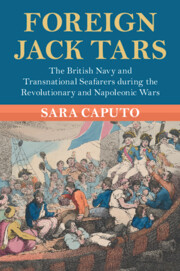 Foreign Jack Tars
Foreign Jack Tars Book contents
1 - Countable ‘Foreigners’
Birthplace and Demographic Profiles
from Part I - The State
Published online by Cambridge University Press: 03 November 2022
Summary
Chapter 1 tackles ‘foreigners’ defined as such on the basis of their birthplace, as recorded in naval crew musters. Statistical analysis of a sample of 4,392 seamen who served in extra-European stations shows that the proportion of foreign-born men rose between the beginning and the end of the French Wars, likely reflecting the increased demand for manpower. Nearly half of them came not from British imperial or ex-imperial territories, but from continental Europe. Questioning the meaningfulness of categorisations by birthplace, however, the chapter also deploys them as a working hypothesis. The results show that Irish-born, rather than foreign-born, seamen displayed the most distinctive demographic patterns, being on average the oldest but disproportionately employed as ‘landsmen’ – the least skilled and lowest-paid rating. Being born abroad affected the likelihood of promotion to petty officer, and in some cases to able seaman, but it otherwise mattered little in determining a man’s position aboard. Rating was also independent of cultural capital, crudely measured through estimated group numeracy. Overall, a line sharply drawn between the men born in the British Isles and Ireland and those born abroad is a relatively poor predictor of demographic or employment differences.
Keywords
- Type
- Chapter
- Information
- Foreign Jack TarsThe British Navy and Transnational Seafarers during the Revolutionary and Napoleonic Wars, pp. 25 - 53Publisher: Cambridge University PressPrint publication year: 2022


